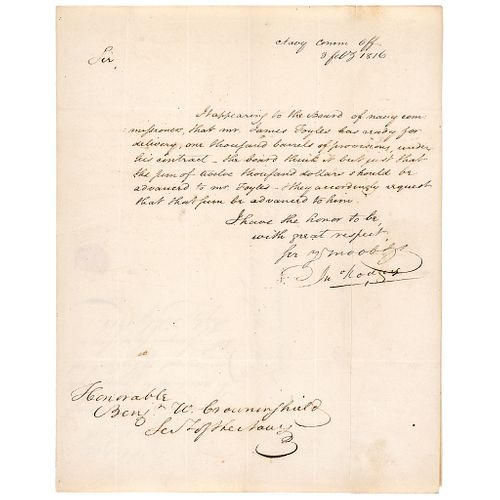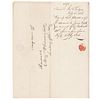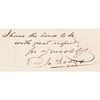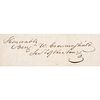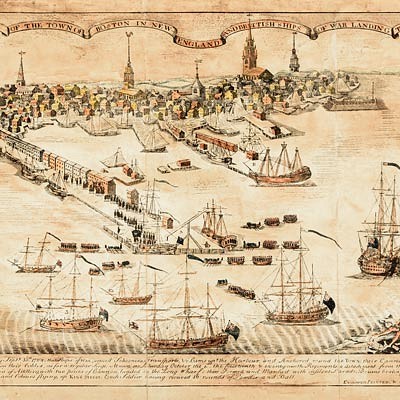Navy COMMODORE JOHN ROGERS War of 1812 Era Autograph Letter Signed
Lot 218
Categories
Estimate:
$400 - $500
Absentee vs Live bid
Two ways to bid:
- Leave a max absentee bid and the platform will bid on your behalf up to your maximum bid during the live auction.
- Bid live during the auction and your bids will be submitted real-time to the auctioneer.
Bid Increments
| Price | Bid Increment |
|---|---|
| $0 | $10 |
| $200 | $20 |
| $300 | $25 |
| $500 | $50 |
| $1,000 | $100 |
| $2,000 | $200 |
| $3,000 | $250 |
| $5,000 | $500 |
| $10,000 | $1,000 |
| $20,000 | $2,000 |
| $30,000 | $2,500 |
| $50,000 | $5,000 |
| $100,000 | $10,000 |
| $200,000 | $20,000 |
| $300,000 | $25,000 |
| $500,000 | $50,000 |
About Auction
By Early American History Auctions
Mar 20, 2021
Set Reminder
2021-03-20 12:00:00
2021-03-20 12:00:00
America/New_York
Bidsquare
Bidsquare : Autographs-Colonial-Political-Americana
https://www.bidsquare.com/auctions/early-american-history-auctions/autographs-colonial-political-americana-6509
330 Lots of Rare, Historic Autographs, Americana, Civil War Era, George Washington, Abraham Lincoln, Slavery & Black History, Revolutionary War Era, Colonial America, Federal Period, War of 1812, Colonial Currency, Indian Peace Medals & more... Early American History Auctions auctions@earlyamerican.com
330 Lots of Rare, Historic Autographs, Americana, Civil War Era, George Washington, Abraham Lincoln, Slavery & Black History, Revolutionary War Era, Colonial America, Federal Period, War of 1812, Colonial Currency, Indian Peace Medals & more... Early American History Auctions auctions@earlyamerican.com
- Lot Description
War of 1812
Commodore John Rogers War of 1812 Era Naval Letter
COMMODORE JOHN ROGERS (1772-1838). Senior Naval Officer in the United States Navy who served under six Presidents in the Quasi-War with France, both Barbary Wars in North Africa, and the War of 1812 with Britain as Rodgers fired the first shot of the War aboard his flagship, the USS President, and played a leading role in the recapture of Washington, DC after the capital was burned by the British, served as Secretary of the Navy in 1823.
February 3, 1816-Dated War of 1812 Era, Autograph Letter Signed, "Jno Rogers" as head of the Board of Navy Commissioners, with Integral Mailing Address Cover, to Benjamin W. Crowninshield (1772-1851), who served as the United States Secretary of the Navy between 1815 and 1818, during the administrations of Presidents James Madison and James Monroe, regarding Naval provisions. In 1815, after the War of 1812 had ended, Congress established the Board of Navy Commissioners. Rodgers was a prolific political writer whose thoughts appealed to President Madison, leading him, with the consent of the Senate, to appoint Rodgers to the Board of Navy Commissioners, along with Isaac Hull and David Porter. Rodgers headed the Board from 1815 through 1824 and again from 1827 until he retired in May 1837. Rodgers also served briefly as Secretary of the Navy in 1823. The Board gave it authority over procurement of naval stores, supplies and material as these related to the construction of naval vessels, outfitting of ships, armament and equipment plus oversight authority over naval shipyards, stations and dry-docks as related to the current Letter. With complete docket and boldly written on clean wove period paper in bold rich brown ink. Some archival reinforcement to fold splits and attractive in eye appeal. This Letter reads, if full:
"Navy Comm Off. - 3 Feby 1816 --- Sir, - It appearing to the Board of navy commissioners, the Mr. James Foyles has ready for delivery, one thousand barrels of provisions, under his contract - the board think it best just that the sum of twelve thousand dollars should be advanced to Mr. Foyles - & they accordingly request that that sum be advanced to him. -- I have the honor to be with great respect Sir your most Obt. - (Signed) John Rogers".
John Rodgers (July 11, 1772 - August 1, 1838) was a senior naval officer in the United States Navy who served under six Presidents for nearly four decades during its formative years in the 1790s through the late 1830s, committing the bulk of his adult life to his country.
His service took him through many operations in the Quasi-War with France, both Barbary Wars in North Africa and the War of 1812 with Britain. As a senior officer in the young American navy he played a major role in the development of the standards, customs and traditions that emerged during this time. Rodgers was, among other things, noted for commanding the largest American squadron in his day to sail the Mediterranean Sea.
After serving with distinction as a lieutenant he was soon promoted directly to the rank of captain (the rank of Master Commandant did not exist at that time).
During his naval career he commanded a number of warships, including the USS John Adams, the flagship of the fleet that defeated the Barbary states of North Africa. During the War of 1812 Rodgers fired the first shot of the war aboard his next flagship, the USS President, and also played a leading role in the recapture of Washington after the capital was burned by the British, while also having to endure his own hometown and house burned and his family displaced. Later in his career he headed the Navy Board of Commissioners and served briefly as Secretary of the Navy.
Following in his footsteps, Rodgers' son and several grandsons and great-grandsons also became commodores and admirals in the United States Navy.
Benjamin W. Crowninshield (1772 - February 3, 1851), served as the United States Secretary of the Navy between 1815 and 1818, during the administrations of Presidents James Madison and James Monroe. Crowninshield became Secretary of the Navy in January 1815, a position almost held by his brother Jacob Crowninshield ten years earlier, and managed the transition to a peacetime force in the years following the War of 1812. This included implementation of the new Board of Commissioners administrative system and the building of several ships of the line, the backbone of a much enhanced Navy. He also oversaw strategy and naval policy for the Second Barbary War in 1815.
After leaving Navy office in 1818, Crowninshield returned to business and political affairs in Massachusetts, prospering in both. In addition to serving two more terms in the Massachusetts House, he was also elected to four terms the United States Congress from 1823 to 1831.
Our Auction Contents:
Black History & Slavery: (Lots 1 - 63)
Abraham Lincoln Related: (Lots 64 - 74)
Historic Autographs: (Lots 75 - 235)
Colonial America: (Lots 236 - 261)
Revolutionary War: (Lots 262 - 304)
George Washington Related: (Lots 305 - 306)
Early American Guns & Weapons: (Lots 307 - 318) - Shipping Info
-
Early American provides in-house worldwide shipping. Please contact us directly if you have questions about your specific shipping requirements.
-
- Buyer's Premium



 EUR
EUR CAD
CAD AUD
AUD GBP
GBP MXN
MXN HKD
HKD CNY
CNY MYR
MYR SEK
SEK SGD
SGD CHF
CHF THB
THB